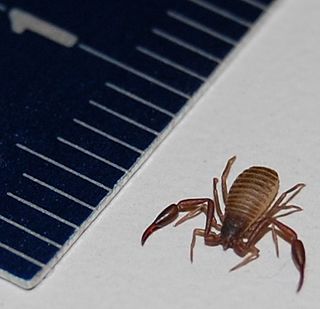
Pseudoscorpions, also known as false scorpions or book scorpions, are small, scorpion-like arachnids belonging to the order Pseudoscorpiones, also known as Pseudoscorpionida or Chelonethida.
Feaella is a genus of pseudoscorpions in the family Feaellidae, first described by Edvard Ellingsen in 1906.
The Sternophoridae are a family of pseudoscorpions with about 20 described species in three genera. While Afrosternophorus is an Old World genus, found mainly in Australasia, the other two genera are found in the New World, from El Salvador to the southern USA and in the Dominican Republic.
Menthidae is a family of pseudoscorpions, first described by Joseph Conrad Chamberlin in 1930.

Chthoniidae is a family of pseudoscorpions within the superfamily Chthonioidea. The family contains more than 600 species in about 30 genera. Fossil species are known from Baltic, Dominican, and Burmese amber. Chthoniidae now includes the former families Tridenchthoniidae, and Lechytiidae which has been demoted to subfamilies.
Bochicidae is a family of pseudoscorpions distributed throughout the Americas from Texas and Mexico to South America, from the Antilles to Venezuela, Guyana and Brazil, as well as in Europe. Members of the family can be diagnosed mainly by features of the claws, notably the presence of exactly 12 trichobothria on each claw and a long, as opposed to short, venom duct. Some species live in caves while some are surface-dwelling.

Chernetidae is a family of pseudoscorpions, first described by Anton Menge in 1855.

Geogarypidae is a family of pseudoscorpions, which was described in 1930 by American arachnologist Joseph Conrad Chamberlin.

Garypinidae is a family of pseudoscorpions, first described by Eugen von Daday in 1889.

Anatemnus is a genus of pseudoscorpions in the Atemnidae family.

Neobisiidae is a family of pseudoscorpions distributed throughout Africa, the Americas and Eurasia and consist of 748 species in 34 genera. Some species live in caves while some are surface-dwelling.
Garypidae is a family of pseudoscorpions, first described by Eugène Simon in 1879.

Cheliferidae is a family of pseudoscorpions in the order Pseudoscorpiones, first described by Antoine Risso in 1827.

Withiidae is a family of pseudoscorpions, first described by Joseph Conrad Chamberlin in 1931.
Austrochthonius is a genus of pseudoscorpions in the family Chthoniidae. It was described in 1929 by American arachnologist Joseph Conrad Chamberlin.
Lagynochthonius is a genus of pseudoscorpions in the family Chthoniidae. It was described in 1951 by Austrian arachnologist Max Beier.
Sathrochthonius is a genus of pseudoscorpions in the family Chthoniidae. It was described in 1962 by American arachnologist Joseph Conrad Chamberlin.
Hyidae is a family of pseudoscorpions. It was described in 1930 by American arachnologist Joseph Conrad Chamberlin.
Ideoblothrus is a genus of pseudoscorpions in the Syarinidae family. It was described in 1892 by Italian naturalist Luigi Balzan as a subgenus of Ideobisium.
Dactylochelifer is a genus of pseudoscorpions in the family Cheliferidae, first described by Max Beier in 1932.








